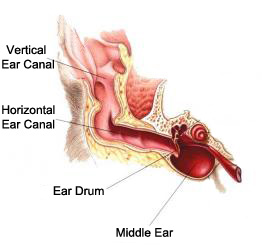Regarding Your Pet, here is some information about Otitis Externa
Description:
Otitis Externa is an inflammation or infection of the ear. The skin of the inner aspects of the ear (pinna) down the ear canal to the eardrum may be affected.
Causes:
- Allergies: This is the most common underlying factor. Allergies cause itchiness. The resulting inflammation and scratching traumatizes the tissues making them vulnerable to secondary infection by bacteria or yeast.
- Parasites: ear mites cause inflammation and result in secondary infection. Occasionally soft-bodied ticks will invade the ear canal.
- Bacteria and Yeast: These organisms are opportunistic and will invade damaged tissues.
- Foreign Bodies: Plant awns or foxtails are the most prevalent foreign body affecting ears.
- Furry and waxy ear canals: Some breeds, notably the Cocker Spaniel, have furry ear canals and excessive wax production which result in a perfect environment for opportunistic yeast and bacterial infections. See Photo below.
Symptoms:
Common signs are:
- Head shaking
- Pawing at the ears
- Whimpering from discomfort
- Redness, heat and pain
- Pus or other discharge
- Foul odor
Diagnosis:
- An otoscopic exam is performed if possible. Pain or pus often precludes this type of exam without sedation.
- Swabs of the ear may be examined under the microscope to determine if yeast, bacteria or mites are involved.
- A culture may be obtained to determine which treatment the infection may be most sensitive to.
Treatment:
- Initial treatment typically requires a thorough ear cleaning to remove excessive pus and debris in the ear canal.
- Appropriate ear medications and oral medications are used as a follow up to resolve the primary or secondary infecting agents (Bacteria, Yeast or mites).
- Fortunate pets have an episode, which resolves when treated. Most pets, however, suffer recurrent bouts of Otitis externa because the infection is secondary to an underlying and persistent allergy. If the allergy is effectively treated, a satisfactory control to the Otitis is possible.
- Treatments for allergies are antihistamines, corticosteroids, or dietary changes in the case of food allergies.
- Periodic ear cleanings are necessary in susceptible pets as a preventative.
Other Information:
Ear Cleaning Technique:
Understanding the anatomy of the ear canal and the location of the ear drum will help you feel comfortable when flushing the ear canal or detailing with a cotton swab.
Notice from the diagram the location of the vertical ear canal, the horizontal ear canal and the eardrum.
When cleaning the ear the vertical canal is filled with cleansing solution. Massaging the ear canal from the exterior side of the face will loosen debris and wax. Your pet may shake its head or reflexively scratch when you do this. Next, you can detail the vertical ear canal and outside of the ear using a cotton swab. Note that as long as the cotton swab is going in the same direction as the vertical ear canal (i.e. up and down), it is impossible to hit or injure the eardrum. Avoid leveling the cotton swab in the direction of the horizontal ear canal as this could allow advancement of the cotton swab toward the eardrum. Poking the eardrum could cause damage or pain.


